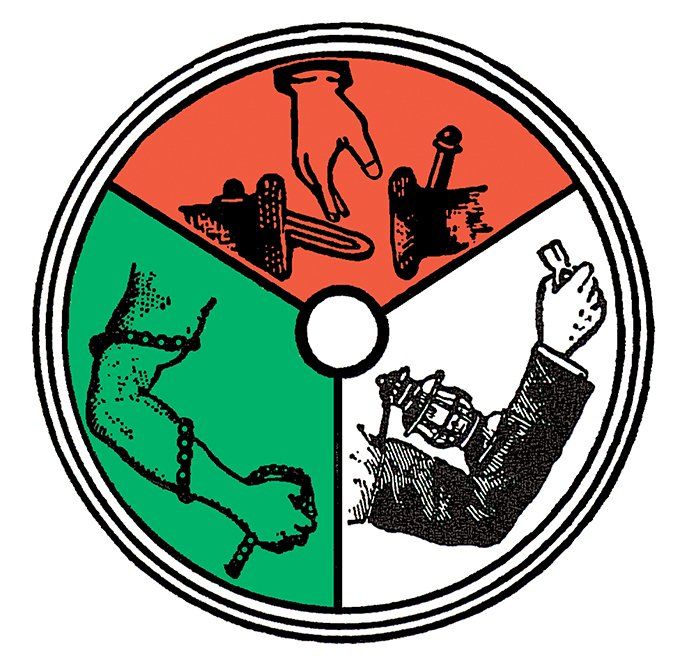ORDER OF RAILWAY CONDUCTORS
In the spring of 1868, T. J. “Tommie” Wright and a small band of Illinois Central Gulf conductors formed the first conductors’ union, known as “Division Number 1 Conductors’ Brotherhood” at Amboy, Illinois. Word spread quickly, and by November 1868, the union’s first convention was held in Columbus, Ohio, where conductors from the U.S. and Canada adopted the name “Order of Railway Conductors of America.”
In 1885, the ORC directed its leaders to aid in negotiating agreements with carriers, a revolutionary idea for the time. In 1890, the ORC adopted a strike clause and began a militant policy of fighting for the welfare of conductors.
In 1942, the Order of Sleeping Car Conductors amalgamated with the ORC, and in 1954 the organization was renamed the Order of Railroad Conductors and Brakemen to reflect its diverse membership.
TIMELINE OF THE ORC
1868: In the spring, T. J. ‘Tommie” Wright organized a little band of Illinois Central conductors into the first “Conductors’ Union,” known as Division No. 1 Conductor’s Brotherhood. Though founded initially as a fraternal group, the men quickly realized their most important common problem was being grossly underpaid.
… On June 1 7 the IC tracks crossed those of the CB&Q at Mendota so word of the new union soon spread and Division No. 2 was founded at Galesburg, Illinois.
… On July 6 the two groups amalgamated, adopted the name ‘Conductor’s Brotherhood,” approved a constitution and bylaws and elected their first grand officers. In just a few short months, Div. No. 3 was formed at Aurora, Illinois, and Div. No. 4 at Centralia, Illinois.
… In November the first international convention of the Conductor’s Brotherhood was held in Columbus, Ohio, with conductors attending from all over the United States and Canada despite the CB&Q’s threat to replace any man who did not “give up the association,” a threat which killed the divisions at Galesburg and Aurora, Illinois.
1878: At its convention, the Brotherhood adopted the name “Order of Railway Conductors of America.” The secretary-treasurer named at this convention was a resident of Cedar Rapids, Iowa, and he kept his records at his home.
1884: The convention, then held annually, chose Cedar Rapids as the permanent home of the Grand Division and its officers. This has continued except for one year, 1 886, when the offices were temporarily located in Chicago. Later the period between conventions was extended to two years, then three, and finally four as it is now.
1885: The fraternal and idealistic objectives of the young organization could not survive under carrier indifference toward wages, working conditions and safety of conductors and the ORC convention in 1885 took a new direction by adopting a measure directing its executives to aid in negotiating agreements with carriers. Settling disputes was regarded as a revolutionary step in the field of labor-carrier dealings at this time – but it was a step essential to the survival of the organization.
1890: The Order adopted a strike clause and began a militant policy of fighting for the welfare of conductors in wages, hours, rules, safety and other issues vital to them. Thousands of new members flocked to the Order’s banner.
1907: Thirty-nine years after Tommie Wright had first gathered his little band of pioneers, the ORC and other railroad labor prevailed upon Congress to pass legislation limiting the hours a railroader could work to 16 out of 24.
1916: ORC President A. B. Garrettson spoke for railroad labor and labor unions generally before Congressional committees considering the eight-hour work-day bill which was passed and became law.
1942: The Order of Sleeping Car Conductors amalgamated with the ORC.
1951-1954: Agreements providing wage increases, cost of living adjustments and rules changes were reached, but the question of the car basis of pay was unsettled. The ORC continued its fight through national handling and mediation to a strike ballot and Presidential Emergency Board 109. President Roy O. Hughes finally got the carriers to agree to a graduated rate of pay system May 26, 1955, and the Order won its longest and most difficult struggle.
1954: While this struggle was taking place, the Grand Division took action changing the name of the Order to the Order of Railway Conductors and Brakemen. The Order had been accepting brakemen as members for 20 years.
1964: On June 25 five years of bitter struggle that began with a multi-million dollar advertising campaign by the carriers in which they called their employees “feather-bedders” was climaxed with a settlement which maintained the roadman’s dual basis of pay (100 miles or eight hours). In addition, paid holidays and expenses away from home were won for road employees.
1966: and since In addition to obtaining wage increases, rule improvements and additional fringe benefits, the Order has won some adjustment of financial inequities in the car scale additives factor, won a uniform national wage rate by eliminating the so-called “Western Rates,” aided in winning a supplemental pension based on years of service and improved its health and welfare plan greatly.
In the spring of 1868, T. J. “Tommie” Wright and a small band of Illinois Central Gulf conductors formed the first conductors’ union, known as “Division Number 1 Conductors’ Brotherhood” at Amboy, Illinois. Word spread quickly, and by November 1868, the union’s first convention was held in Columbus, Ohio, where conductors from the U.S. and Canada adopted the name “Order of Railway Conductors of America.”
In 1885, the ORC directed its leaders to aid in negotiating agreements with carriers, a revolutionary idea for the time. In 1890, the ORC adopted a strike clause and began a militant policy of fighting for the welfare of conductors.
In 1942, the Order of Sleeping Car Conductors amalgamated with the ORC, and in 1954 the organization was renamed the Order of Railroad Conductors and Brakemen to reflect its diverse membership.
TIMELINE OF THE ORC
1868: In the spring, T. J. ‘Tommie” Wright organized a little band of Illinois Central conductors into the first “Conductors’ Union,” known as Division No. 1 Conductor’s Brotherhood. Though founded initially as a fraternal group, the men quickly realized their most important common problem was being grossly underpaid.
… On June 1 7 the IC tracks crossed those of the CB&Q at Mendota so word of the new union soon spread and Division No. 2 was founded at Galesburg, Illinois.
… On July 6 the two groups amalgamated, adopted the name ‘Conductor’s Brotherhood,” approved a constitution and bylaws and elected their first grand officers. In just a few short months, Div. No. 3 was formed at Aurora, Illinois, and Div. No. 4 at Centralia, Illinois.
… In November the first international convention of the Conductor’s Brotherhood was held in Columbus, Ohio, with conductors attending from all over the United States and Canada despite the CB&Q’s threat to replace any man who did not “give up the association,” a threat which killed the divisions at Galesburg and Aurora, Illinois.
1878: At its convention, the Brotherhood adopted the name “Order of Railway Conductors of America.” The secretary-treasurer named at this convention was a resident of Cedar Rapids, Iowa, and he kept his records at his home.
1884: The convention, then held annually, chose Cedar Rapids as the permanent home of the Grand Division and its officers. This has continued except for one year, 1 886, when the offices were temporarily located in Chicago. Later the period between conventions was extended to two years, then three, and finally four as it is now.
1885: The fraternal and idealistic objectives of the young organization could not survive under carrier indifference toward wages, working conditions and safety of conductors and the ORC convention in 1885 took a new direction by adopting a measure directing its executives to aid in negotiating agreements with carriers. Settling disputes was regarded as a revolutionary step in the field of labor-carrier dealings at this time – but it was a step essential to the survival of the organization.
1890: The Order adopted a strike clause and began a militant policy of fighting for the welfare of conductors in wages, hours, rules, safety and other issues vital to them. Thousands of new members flocked to the Order’s banner.
1907: Thirty-nine years after Tommie Wright had first gathered his little band of pioneers, the ORC and other railroad labor prevailed upon Congress to pass legislation limiting the hours a railroader could work to 16 out of 24.
1916: ORC President A. B. Garrettson spoke for railroad labor and labor unions generally before Congressional committees considering the eight-hour work-day bill which was passed and became law.
1942: The Order of Sleeping Car Conductors amalgamated with the ORC.
1951-1954: Agreements providing wage increases, cost of living adjustments and rules changes were reached, but the question of the car basis of pay was unsettled. The ORC continued its fight through national handling and mediation to a strike ballot and Presidential Emergency Board 109. President Roy O. Hughes finally got the carriers to agree to a graduated rate of pay system May 26, 1955, and the Order won its longest and most difficult struggle.
1954: While this struggle was taking place, the Grand Division took action changing the name of the Order to the Order of Railway Conductors and Brakemen. The Order had been accepting brakemen as members for 20 years.
1964: On June 25 five years of bitter struggle that began with a multi-million dollar advertising campaign by the carriers in which they called their employees “feather-bedders” was climaxed with a settlement which maintained the roadman’s dual basis of pay (100 miles or eight hours). In addition, paid holidays and expenses away from home were won for road employees.
1966: and since In addition to obtaining wage increases, rule improvements and additional fringe benefits, the Order has won some adjustment of financial inequities in the car scale additives factor, won a uniform national wage rate by eliminating the so-called “Western Rates,” aided in winning a supplemental pension based on years of service and improved its health and welfare plan greatly.

